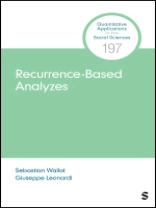This book introduces techniques developed in physics and physiology for characterizing and analyzing patterns in time series data to a broad audience of social scientists. In contrast to time-series regression and related techniques, recurrence quantification analysis (RQA) has its background in chaos and nonlinear dynamical systems—theory arguably very relevant to social processes. The goal of Recurrence-Based Analyses is to introduce readers to these techniques that can characterize a system’s complexity, stability and instability, and conditions under which it transitions from one state to another. The authors illustrate concepts and techniques with relevant social science examples at different temporal scales: biweekly polling data on federal elections in Germany; daily values of three stock market indices; daily cases of Sars Cov-19 in four countries during the pandemic; and second-by-second vocalizations of mothers and infants interacting recorded by motion cameras. This introduction to RQA serves as a useful supplement to undergraduate and graduate courses in computational social science, and also by researchers who seek new tools to address social scientific questions in new ways.
Зміст
Series Editor Introduction
Acknowledgments
About the Authors
Acronyms and Notation
Chapter 1: What is Recurrence Analysis?
The Recurrence Plot
Deriving Recurrence Measures
Advantages and Limitations of Recurrence Analysis
Chapter 2: The Basics of Recurrence Analysis—Univariate RQA
Parameter Estimation
The Delay Parameter t
The Embedding Parameter m
The Radius Parameter e
Further Parameters
Summarizing RQA Outputs
Chapter 3: The Bi-Variate Case: Cross-Recurrence Quantification Analysis
Introduction to CRQA
Standardization
Alignment
The Cross-Recurrence Plot (CRP)
Using CRQA With Continuous Data: Stock Market Fluctuations
Using CRQA With Categorical Data
Chapter 4: The Diagonal-Wise Cross-Recurrence Profile (DCRP)
Diagonal-Wise Cross Recurrence Profiles (DCRP)
Building a Baseline by Means of Shuffling
Chapter 5: Windowed Recurrence Analysis
Introduction to Univariate Windowed Recurrence Analysis
Windowed Cross-Recurrence Analysis
Using Windowed Recurrence Analysis for Continuous Monitoring
Chapter 6: Multivariate Analysis: Multidimensional Recurrence Quantification Analysis (Md RQA)
Introduction to Md RQA
Multidimensional Cross-Recurrence Quantification Analysis (Md CRQA)
An Example Using Multidimensional RQA on Political Polling Data
Chapter 7: Sample Analysis and Practicalities
Calculating General Parameters
Time Series Length
Computing Confidence Bounds Via Boot-Strapping
Parameter Exploration
Surrogate Analysis
Dealing With Multiple Recurrence-Measures
Chapter 8: Conclusion
Further Applications
Finding Software
A Final Note
References
Index
Про автора
Giuseppe Leonardi obtained his MA degree in psychology from the University of Padua (Italy) and his Ph D in experimental psychology at the University of Trieste (Italy). As a visiting student he was at the Center for Complex Systems at Florida Atlantic University (USA). His interests gradually focused on a dynamical approach in behavioral interactions and the methodological challenges this new approach requires. He especially concentrated on RQA and its applications to human language and cooperative behavior. From 2017 he has been at the University of Economics and Human Sciences in Warsaw (Poland), where he serves as dean of the School of Human Sciences since 2019.












